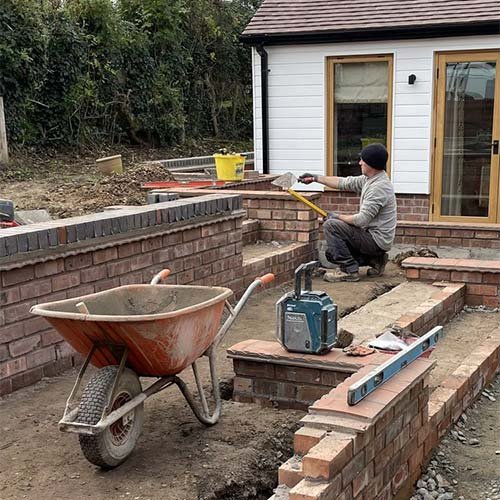The 10-Second Trick For Bricklayer Auckland
Wiki Article
Get This Report on Bricklayer Auckland
Table of ContentsExcitement About Bricklayer AucklandThe Facts About Bricklayer Auckland Uncovered10 Simple Techniques For Bricklayer AucklandSee This Report about Bricklayer AucklandThe Ultimate Guide To Bricklayer AucklandAn Unbiased View of Bricklayer Auckland
The scaffolding needed have to be planned prior to the work begins. It has to be constructed in such away as to trigger the least disturbance with other crew members. Blocks need to always be stacked on planks; never ever load them directly on uneven or soft ground. Do not keep bricks on scaffolds or runways.Except where stacked in sheds, brick stacks ought to never ever be greater than 7 feet high. When a stack of brick reaches an elevation of 4 feet, it must be tapered back 1 inch in every foot of elevation over the 4-foot level. The tops of brick piles have to be maintained level, and also the taper have to be maintained during unpiling procedures.
Structural bond describes just how the specific stonework devices interlock or tie with each other into a single structural unit. You can accomplish architectural bonding of brick and ceramic tile wall surfaces in one of the complying with 3 methods: Overlapping (interlocking) the masonry units. Embedding metal ties in linking joints. Using cement to stick adjacent wythes of masonry.
The Best Guide To Bricklayer Auckland
Pattern bond refers to the pattern created by the stonework devices and mortar joints on the face of a wall surface (Bricklayer Auckland). The pattern may arise from the architectural bond, or it might be simply decorative as well as unconnected to the architectural bond. Figure 4-4 shows the 6 fundamental pattern bonds in usual use today.The running bond is the simplest of the six patterns, containing all stretchers. Since the bond has no headers, steel connections typically create the structural bond. The running bond is used mostly in dental caries wall building, brick veneer wall surfaces, and also encountering floor tile wall surfaces made with extra wide cot ceramic tile.
Excellent blocks need to not degenerate when put in water. Only when fat lime or clay mortar is utilized or when one is forced to utilize blocks that are not well charred, this saturating regulation has actually to be relaxed.
The Basic Principles Of Bricklayer Auckland
In all cases, bricks should not be dealt with in baskets or in any various other setting which will damage the intensity of their edges. Just how do you develop a masonry wall? The operation of bricklaying in average basic job is as complies with. A layer of mortar visite site is spread out to cover the complete width of the wall surface for a suitable size of the reduced program.
We press the side bulging mortar in firmly to be level with the face of the wall surface if it is to be left unplastered. In the usual practice taken on by many masons, a row of bricks is first put on a slim layer of bed mortar leaving the cross joints vacant.


The wall surfaces are raised genuinely plumb. All programs are laid truly horizontal and all upright joints genuinely vertical.
8 Simple Techniques For Bricklayer Auckland
For this purpose, a wooden straight edge with college graduation giving a density of each brick program including joint can be made use of for advice. For a thick wall surface, the above procedure is repeated along with both faces of the wall surface and the interior filling up blocks for the thick wall surface are laid in a comparable way.
This operation of loading open joints is termed flushing-up. It is incorrectly left out for numerous courses on he has a good point some badly-executed jobs and also only done later on (not after every course) in an inefficient way. It is not an excellent method and needs to be stayed clear of as it is vital that every course needs to be purged approximately the degree if great is needed.

The Buzz on Bricklayer Auckland
The mortar increasing and filling up the upright joints totally and also develops an exceptionally solid and strong wall. This is called larrying. For a rat catch bond job (as in the building of tooth cavity wall surfaces), if the mortar is placed thoughtlessly on the block, several of it will fall under the cavities and will certainly be squandered.The face of the brickwork shall also be cleaned of all mortar droppings, etc(ii) When situations render it needed to continue a part of a structure in uneven programs, the job will be constructed back (according to the bond utilized on the work) at an angle not steeper than 45 degrees so regarding ensure an uniform and also effective bonding.
Otherwise, for faces to be plastered, finishing of the face joints ought to be executed as talked about in below (This is very essential.)(iv) The wall surfaces must be consistently raised throughout not leaving any kind of part one metre (three feet) less than the other - Bricklayer Auckland. A day's job need to not be even more than 1.
Not known Details About Bricklayer Auckland
When the facework is to be later plastered check my site or the joints alone are to be sharp, the joints need to be raked while the wall is being developed. Bricklayer Auckland. It needs to be raked to a minimum depth of 12 mm by a raking tool throughout the progress of the work itself, when the mortar is still eco-friendly.
If smudging or pointing is not envisaged, the joints should be struck flush as well as finished at the time of laying itself, as already mentioned. Half-brick walls have a tendency to break unless care is absorbed its construction. Brickwork in half-brick stonework is to be executed with cots in 1: 5 mortar.
Report this wiki page